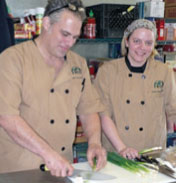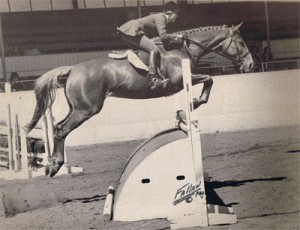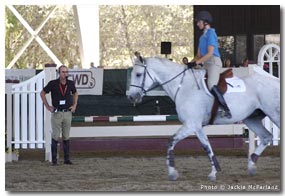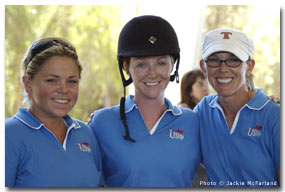By Tammy Chipko
I was honored to speak with George Morris regarding the 2007 USEF Talent Search Finals West. Anyone who has communicated with George Morris understands his passion and love for the horse and the sport. He is a man with strong opinions, a wealth of knowledge and is well-respected on a multitude of levels.
Tammy Chipko: I asked George if he would take a few minutes and allow me to interview him regarding the USEF Finals. George has a very unique way of asking and answering his own questions, which made my job extremely easy. Here is his take on the finals.
George Morris: First off let me say that Jeffrey Welles (my co-judge) was a superb judge. He has a great feel for a rider. He looks for a rider that gets the most from their horse. I truly enjoyed judging with him and strongly recommend him for future USEF Finals. Also, I have to say that Griffith Park is a wonderful facility to hold the USEF Finals. The facility is well kept and has a beautiful presence. I hope they continue to host these Finals. To have the indoor ring, under the lights, for the first two phases is wonderful. To go out on the field for the third final allows for great diversity.
TC: How did you decide what to ask of the riders in the first phase on the flat?
GM: My main focus is horsemanship. This means the condition, care, and turn out of the horse and rider. The presentation is of the utmost importance to me. A good horseman is scrupulously clean! (Take note: Archie Cox said the same thing when EquestriSol interviewed him for the Jr. Hunter Finals!) The horse must look healthy, happy, and sound. I find it discouraging that so many riders are not meticulous. Real horsemanship is lost in this country due to too much showing and not enough attention to detail.
Due to the format we did not have much time so I looked for riders that were able to execute what was asked of them in a positive and definite manner. I believe in strong basics. Keeping it simple is a positive thing for both horse and rider. Good extensions and collection work shown as well as possible is what I was looking for.
TC: Both you and Jeffrey Welles designed the gymnastics phase. What were you hoping to see?
GM: I believe the Gymnastics phase should prepare the horse and rider for a course of fences. That is why I call this a course of gymnastics! Having this portion indoors under the lights makes it a bit more difficult so we took that into consideration. We set a course of gymnastics that were a set of problems, starting with easy problems and progressing to more difficult problems. We asked questions in this phase, whether to add strides or leave out strides. The line that was set against the rail had a short three stride, to a two stride, to an option of a four or five stride line. It was much more difficult to show a correct five strides than a forward flat four strides. Now of course if you have a large strided horse and could make the four strides work than that is the exception. This is a Jumper-type medal, and if that last fence had been a foot taller most would have had it down.
TC: The vertical liverpools in a figure eight were also challenging.
GM: I love problems! Who can solve problems? Who has done their homework? I set the first vertical liverpool off a related distance. This allowed the riders to get going. The second liverpool was set off a tight turn away from the in-gate and was backwards. This showed me who had done their homework. You must be prepared. If you were not able to collect your horse with impulsion you were sure to have the rail down. This happened a lot.
TC: What was your approach in designing the final round on the grass field in the rain?
GM: Jeffrey and I designed a subtle course. We again wanted to produce a problem solving course. The first and second fences were set as an option away from the in-gate. If your horse drifted towards the gate it made it much more difficult. I personally did not mind six or seven strides as long as it was done early.The bank presented problems for some as well as the blind turn to the Swedish oxer. I again set this so that the high side was on the left. If your horse bulged out of the turn you would hit the high side (homework, homework, homework).
Of course the open water is always problematic. Some of the riders rode too hard at it and that made the next element very difficult. These kids do not jump the water enough. This course was about solving problems, not alleviating them. We as Americans take problems away. We make everything comfortable. I believe in problems. I believe in teaching riders to solve problems. That will make great riders.
TC: The final phase came with pouring rain and mud. Did this influence your judging in any way?
GM: I loved the rain and the mud! I was happy to have it. In Europe they show in this type of weather all of the time. This raised the bar and created discomfort and problems for everyone. Those who dealt with problems, including this one, made the top cut.
TC: Next and final was the top four. What were you looking for in these rounds?
GM: This should be ridden like a jump-off round. We reversed some of the fences creating different problems. There was significant distance between a couple of the elements which made for a lot of galloping. Time faults were a result of riders not galloping. Again, do your homework!
The final four pinned themselves. Judges were not needed. The girl that won (Natalie Rae Medlock) was focused, very correct. She had a great sense of the fence and the horse. She had a relaxed energy.
TC: Any last words?
GM: Do your homework. Practice uncomfortable. Don’t avoid problems, make problems and learn to solve them. I don’t care about feeling good – I want to accomplish good!
Congratulations to everyone who competed in the 2007 USEF Talent Search Finals West, especially the top four: Natalie Rae Medlock, Tina Dilandri, Allison LaJoie and Michelle Morris.
Thank you, George, for a wonderful interview. George Morris is the USEF Chef d’Equipe.
 Chef Ric Orlando and his team have set a new standard for horse show dining and it’s yours for the tasting at Thermal. Now that the all-new HITS Oasis Club is open daily for breakfast and lunch at the HITS Desert Horse Park, members can savor the many fabulous flavors throughout the day.
Chef Ric Orlando and his team have set a new standard for horse show dining and it’s yours for the tasting at Thermal. Now that the all-new HITS Oasis Club is open daily for breakfast and lunch at the HITS Desert Horse Park, members can savor the many fabulous flavors throughout the day. Desserts to die for include: Phyllo Cups with Lemon Curd and Fresh Berries, Chocolate-Glazed Macaroons, Chocolate Truffle Cups.
Desserts to die for include: Phyllo Cups with Lemon Curd and Fresh Berries, Chocolate-Glazed Macaroons, Chocolate Truffle Cups. Imagine watching the art of good riding: jumping hunt obstacles that ask different questions of horse and rider – negotiating turns, establishing a true hunter pace, trotting a wide fence like one you might find in the country.
Imagine watching the art of good riding: jumping hunt obstacles that ask different questions of horse and rider – negotiating turns, establishing a true hunter pace, trotting a wide fence like one you might find in the country.
